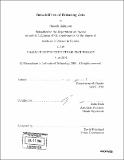Instabilities of rotating jets
Author(s)
Zahniser, Russell, 1982-
DownloadFull printable version (2.787Mb)
Other Contributors
Massachusetts Institute of Technology. Dept. of Physics.
Advisor
John Bush.
Terms of use
Metadata
Show full item recordAbstract
When a jet of water is in free fall, it rapidly breaks up into drops, since a cylinder of water is unstable. This and other problems involving the form of a volume of water bound by surface tension have yielded a wealth of theoretical and experimental results, and given insight into such phenomena as the shape of the Earth. Particularly interesting behaviors tend to emerge when the fluid in question is rotating; a drop may, for example, form a toroidal or ellipsoidal shape or even stretch out into some multi-lobed, non-axisymmetric form. In this paper, we investigate the properties of a rotating jet of water, and determine what regime of the parameter space are dominated by the various forms of instability. This is both predicted theoretically and demonstrated to be accurate experimentally. If we watch a jet of water as the rotation rate is gradually increased from zero, the drop size will start shrinking gradually, and then suddenly, rather than a single row of drops, we will see the jet breaking up into two-lobed, bar shaped forms, like the rung of a ladder. The point at which this transition occurs is characterized in terms of the rotational Bond number, B₀ = ... . The critical B₀ may be as low as 6, if there is a strong bias imparted by vibration of the table at an appropriate frequency, but for a perfectly quiescent rotating jet the second mode does not become dominant until a higher B₀. As the rotation rate is increased above this, the instability grows gradually more dramatic, and eventually the two lobes of each drop are breaking apart and flying outward. Then a transition to a third mode will occur, with three lobes in each drop; this is possible from a B₀ of 12, and dominant above a B₀ slightly higher than that. In general, mode m may occur whenever (cont.) B₀ > m(m + 1).
Description
Thesis (S.B.)--Massachusetts Institute of Technology, Dept. of Physics, 2004. Includes bibliographical references (p. 33-34).
Date issued
2004Department
Massachusetts Institute of Technology. Department of PhysicsPublisher
Massachusetts Institute of Technology
Keywords
Physics.